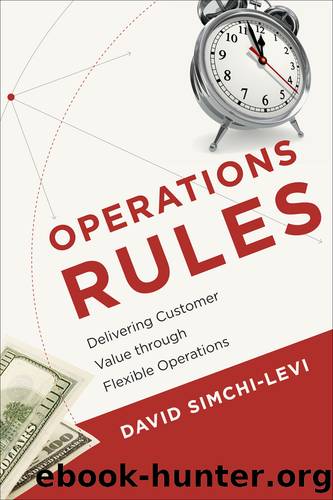Operations Rules by Simchi-Levi David;

Author:Simchi-Levi, David; [Simchi-Levi, David]
Language: eng
Format: epub
ISBN: 3339161
Publisher: MIT Press
Published: 2010-08-15T00:00:00+00:00
* * *
Shipment tracking
Pipeline visibility
Track and trace
Efficiency
Low
Medium
High
Responsiveness
High
Medium
High
Risk
Low
High
High
Regulations
Not capable
Depends
High
Cost
Low
Medium
High
* * *
5. Performance monitoring and optimization This is perhaps the one area that executives understand well. IT infrastructure allows companies to collect information throughout the supply chain, access any data in the system from a single point of contact (all available information can be accessed in one stop and is consistent independent of the mode of inquiry), analyze and optimize to plan activities and make trade-offs, and finally monitor the status of the supply chain.
What is less understood is the need not only to monitor the current performance of the supply chain by tracking various key performance indicators but also to predict what is likely to happen in the near future so that corrective action steps can be taken. This suggests a need to complement key performance indicators (KPIs) with key performance predictors (KPPs). For example, monitoring KPIs such as inventory and service levels may suggest that no action needs to be made, but reviewing shipment tracking data may indicate that lead times are likely to increase, thus requiring either more inventories or suggesting the need to expedite shipments.
Similarly, insights obtained from analyzing a supplierâs behavior, using financial information available on public companies, and correlating the data with supplier performance (such as lead time, service level, or quality) allow the firm to develop a supplier score. A supplier score is much like a credit score applied by the financial industry to estimate the likelihood that an individual consumer will default on future payments. In operations, a supplier score ranks suppliers according to the likelihood that they will default on future commitments (such as on-time delivery and quality) because of financial problems or labor disruptions. Such scoring systems may motivate the buyer to purchase more inventory in advance of a (projected) supplier bankruptcy, lead to a dual sourcing strategy for all high-risk suppliers, or start a search for an alternate supplier.
Cisco has gone a step further and developed a resiliency scorecard that includes four categoriesâcomponent resiliency, supplier resiliency, manufacturing resiliency, and test-equipment resiliency. The resiliency scorecard serves as a predictor of areas with potential risk and therefore directs the firm in taking corrective actions depending on the source of risk. Cisco updates the resiliency scorecard for products already in the market on a quarterly basis. For new products, Cisco updates the scorecard at key milestones during the product development lifecycle. This is a systematic, analytical approach that ranks various sources of risks based on their likelihood and potential impact (see chapter 5 for additional discussion).
Rule 6.2
IT should be used not only to monitor current supply chain performance but also to predict what is likely to happen if no corrective action is taken.
6.2 IT and Business Processes
In addition to the investment dilemma that exists when considering information technology investments, a second dilemma that executives sometimes face is the business process dilemma, which emerges after a decision is made to invest in IT.
Download
This site does not store any files on its server. We only index and link to content provided by other sites. Please contact the content providers to delete copyright contents if any and email us, we'll remove relevant links or contents immediately.
Hit Refresh by Satya Nadella(8854)
The Compound Effect by Darren Hardy(8508)
Change Your Questions, Change Your Life by Marilee Adams(7372)
Nudge - Improving Decisions about Health, Wealth, and Happiness by Thaler Sunstein(7242)
The Black Swan by Nassim Nicholas Taleb(6763)
Deep Work by Cal Newport(6563)
Daring Greatly by Brene Brown(6222)
Rich Dad Poor Dad by Robert T. Kiyosaki(6174)
Principles: Life and Work by Ray Dalio(5961)
Man-made Catastrophes and Risk Information Concealment by Dmitry Chernov & Didier Sornette(5646)
Playing to Win_ How Strategy Really Works by A.G. Lafley & Roger L. Martin(5498)
Digital Minimalism by Cal Newport;(5389)
Big Magic: Creative Living Beyond Fear by Elizabeth Gilbert(5351)
The Myth of the Strong Leader by Archie Brown(5237)
The Slight Edge by Jeff Olson(5200)
Discipline Equals Freedom by Jocko Willink(5157)
The Motivation Myth by Jeff Haden(5003)
Stone's Rules by Roger Stone(4857)
The Laws of Human Nature by Robert Greene(4773)
